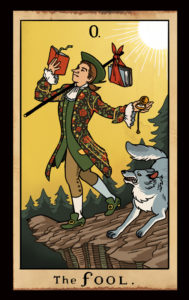IN TAROT, AS IN LIFE, the “meanings” we assign to people and situations affect our feelings about them. Those feelings, in turn, influence our actions … and our actions impact our outcomes. So it makes sense that we take a minute to re-consider our first-impression interpretations before acting on them.
Tarot, smarty-pants that it is, keeps an ace up its sleeve. When it would benefit us to look beyond the face value of a person, place, or thing, tarot simply hands us a card upside down! These upturned cards, called “reversals,” invite us to explore alternative interpretations of the upright card meanings.
 For example, upright, the King of Pentacles signifies a mature, affluent person, one who has earned his current position and who, like the CEO of a corporation, is likely in charge of others’ financial well-being. He’s typically seen as generous but conservative—a guy who will carefully consider your request for an investment, and then perform his due diligence before committing a penny to the project.
For example, upright, the King of Pentacles signifies a mature, affluent person, one who has earned his current position and who, like the CEO of a corporation, is likely in charge of others’ financial well-being. He’s typically seen as generous but conservative—a guy who will carefully consider your request for an investment, and then perform his due diligence before committing a penny to the project.
 Turn him on his head, however, and he may be barely keeping up appearances! For instance, the reversed King of Pentacles could signify someone who’s had a big loss in the stock market and is just managing to tread water. Alternatively, he might run squarely against the grain of his cautious-but-generous reputation, being instead miserly or cold-hearted or even rash. Perhaps he’s malicious and domineering—or, on the other hand, totally lacking in the sort of confidence you’d expect from someone in his position.
Turn him on his head, however, and he may be barely keeping up appearances! For instance, the reversed King of Pentacles could signify someone who’s had a big loss in the stock market and is just managing to tread water. Alternatively, he might run squarely against the grain of his cautious-but-generous reputation, being instead miserly or cold-hearted or even rash. Perhaps he’s malicious and domineering—or, on the other hand, totally lacking in the sort of confidence you’d expect from someone in his position.
All this to say that, while upright tarot cards are relatively straightforward, reversals tend to be trickier and more complex. Which is fine, because life is pretty tricky, too. And since what’s true in life is often even more true in fiction, let’s pay heed to tarot and Joni Mitchell and make sure our characters take the time to look at “both sides now.”
Tarot writing prompt
Write scenes based on the following bold-faced suggestions (ignoring my examples, unless they seem like fun!).
1. Give your character a challenge to face. For example, maybe that King of Pentacles is your character’s boss, and he’s just turned her down for a raise—after hiking her male office mate’s salary.
2. Let your character have a face-value opinion of the situation. Since her coworker got his raise, your character concludes her boss is biased against women in the workplace.
3. Assign your character an emotion or attitude based on her interpretation of the situation. She’s resentful her misogynistic boss won’t cough up the raise she’s requested.
4. Put your character into action based on her belief-driven emotion or attitude (more fun, of course if this action is going to get her in trouble!). She goes to HR and files a complaint of discriminatory treatment.
5. Fast forward to the outcome of the action. After an escalating legal battle, her boss ends up suing her for defamation of character!
But what if, way back at step one, you turned the situation upside down? What if you shook the abundant possibilities from it like long-saved silver dollars from a piggy bank?
In that case, your character might consider her boss’s reluctance to grant her a raise a signal that the company isn’t doing well. And maybe her research proves that’s true. And maybe she discovers that her boss favors her coworker because that young man was her boss’s deceased son’s best friend. (Hello, subplot!) And maybe her sympathy for her boss fuels her determination to save the company—and maybe she fails, but her efforts catch the eye of the CEO of a rival company, who offers her a VP position, making twice what she’d asked her boss for in the first place!
I dunno. It’s worth exploring. Because, like Robert Frost (sort of) tells us in “The Road Not Taken,” the meaning your character assigns a situation can make all the difference—to deepening her own experience and perhaps that of her eventual reader, as well.
Thanks to U.S. Games Systems, Inc. for kind permission to use the image of the King of Pentacles from the DREAMING WAY TAROT.




